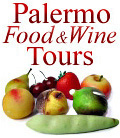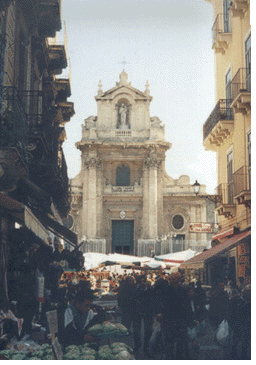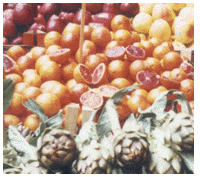...Best of Sicily presents... Best of Sicily Magazine. ... Dedicated to Sicilian art, culture, history, people, places and all things Sicilian. |
by Roberta Gangi | |||||
Magazine Index Best of Sicily Arts & Culture Fashion Food & Wine History & Society About Us Travel Faqs Contact Map of Sicily
|
Sicily's outdoor market tradition dates from the ninth-century Saracen rule of the island, which explains their striking similarity to Arab souqs. Even some of their names are Arabic in origin; Palermo's Ballarò comes to mind. The weather helps. Outdoor vendors find a pleasant environment in coastal cities where it hardly ever gets cold enough to snow. That's not to say that Sicily's markets will be found only in the largest cities. Almost every town and urban neighbourhood has its "mercatino" ("little market") open once a week. Especially in the Arabs' beloved Bal'harm (today's Palermo), where the open air markets occupy narrow medieval streets and the local dialect bears the marks of the Arabic tongue, the visitor might be forgiven for thinking that he or she has wandered into an old quarter in Cairo, Tunis, Jerusalem or Baghdad. Here in Sicily's markets, there are more churches and fewer mosques, more miniskirts and fewer veils, but the character has remained essentially the same over these last nine centuries. That's remarkable if you consider that some of the outdoor markets stand on the very same sites today as they did in the tenth century. With the exception of some Norman-Arab architecture and a number of words in the Sicilian language, the markets are perhaps the best-preserved of Sicily's Arab traditions. Following in the footsteps of their medieval predecessors, Sicily's new North African immigrants --a growing presence in Palermo-- feel perfectly at home here, and are beginning to establish businesses in the Palermitan "souks." In Catania, so frequently the prey of earthquakes and volcanic eruptions, the architecture is more open, the historical quarters having been largely rebuilt. Here in eastern Sicily's main city the markets are located not in narrow medieval streets but in open Baroque squares. The largest is in Piazza Carlo Alberto (shown here), flanked by picturesque churches and monasteries. Another, located near the cathedral, is part of a vast fish market, now expanded to sell just about everything. It's a gourmet chef's delight. In comparing the Palermitan and Catanian markets, one is struck by the greater variety of seafood and produce available in the latter. Catania's markets sell more kinds of artichoke, mushroom and The open air markets are a great place to soak up some local atmosphere even if you don't actually buy anything. You'll have to know where to find them, hidden as they are from the main streets. Siracusa, Messina, Trapani and other major Sicilian cities also boast large markets, but nothing as extensive as those in Palermo and Catania. Here's a simple guide to finding Sicily's five largest outdoor markets in Sicily's two largest cities. In Palermo: Located a few steps from the Martorana Church and Quattro Canti, the Ballarò market extends from Piazza Ballarò in the Albergheria district (near the church of San Nicolò) along Via Ballarò past Piazza Carmine toward Corso Tukory, roughly parallel to Via Maqueda toward the main train station. The Capo market, located behind the Teatro Massimo, extends from Via Porta Carini off Via Volturno near the old city wall toward Piazza Beati Paoli and can also be reached from Via Sant'Agostino, which runs off Via Maqueda, though this section includes various vendors of dry goods and articles other than food. Vucceria (from the Norman French "boucherie"), perhaps the favourite Palermitan market for visitors, begins at Piazza San Domenico, off Via Roma, running parallel to Via Roma (from which it is hidden) along Via Maccheronai toward Piazza Caracciolo and Corso Vittorio Emanuele, branching off along Via Argenteria. Palermo's markets are usually open all day (from around 9 AM to 7 PM) except Wednesday, when they close around 2 PM, and they're closed Sundays. In Catania: The Piazza Carlo Alberto market is located in a large square (named for one of the nineteenth-century Piedmontese kings) near Via Umberto and Corso Sicilia, easily reached from Via Pacini off Via Etnea near the Villa Bellini park. The Pescheria ("fish market") is located off Piazza Duomo near the cathedral and fountain ("dell'Amenano"), between Via Garibaldi and Via Pacini, extending along Via Gemelli Zappalà and some of the nearby streets. Catania's markets are closed Sundays and most afternoons. About the Author: Roberta Gangi has written numerous articles and one book dealing with Italian cultural and culinary history. This is her second article for Best of Sicily Magazine. | ||||
Top of Page |


 From market to table!
From market to table!  A Sicilian street market is a cacophony of sights and sounds. From a colourful assortment of fruits, vegetables, fish and meats to vendors barking about bargains for anybody who will listen. The ambience is punctuated by colored tarpaulins suspended as "tents" to protect the wares from the elements. Italian and foreign items vie for your attention --tarocchi (blood oranges), giri (leafy greens), chicory, herbs, artichokes, cuttlefish, swordfish, prawns, gutted goats, lambs, breads and cheeses. And that's just the beginning.
A Sicilian street market is a cacophony of sights and sounds. From a colourful assortment of fruits, vegetables, fish and meats to vendors barking about bargains for anybody who will listen. The ambience is punctuated by colored tarpaulins suspended as "tents" to protect the wares from the elements. Italian and foreign items vie for your attention --tarocchi (blood oranges), giri (leafy greens), chicory, herbs, artichokes, cuttlefish, swordfish, prawns, gutted goats, lambs, breads and cheeses. And that's just the beginning. broccoli than what you'll find in Palermo. The Carlo Alberto market, in particular, sells more things, like cheeses and salad ingredients, that are ready to eat.
broccoli than what you'll find in Palermo. The Carlo Alberto market, in particular, sells more things, like cheeses and salad ingredients, that are ready to eat.